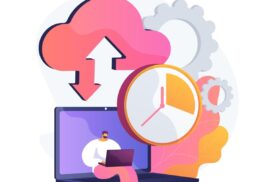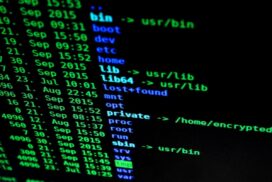Computer Servicing in an Era of Internet of Things (IoT)
The internet of things (IoT) is a network of interrelated devices that connect and exchange data with other IoT devices and the cloud. IoT devices, equipped with sensors and software, can range from consumer objects to mechanical and digital machines. Increasingly, businesses are utilizing IoT to improve efficiency, customer service, decision-making, and overall value. With IoT, data can be transferred over a network without human interaction. This network can consist of a wide variety of devices, including personal heart monitors, cars with built-in sensors, and other objects with internet connectivity. IoT devices collect and send data to an IoT gateway, which acts as a central hub for data transmission and analysis. The use of IoT in computer servicing allows for remote diagnosis and repair, improved maintenance schedules, and enhanced system performance.
As the Internet of Things continues to evolve, computer servicing is shaping the way we maintain and optimize interconnected systems. In this article, we will explore the importance of IoT in computer maintenance, how it works, the pros and cons of IoT, and the standards and frameworks that drive its operation. Join us as we delve into the fascinating world of computer servicing in the era of Internet of Things.
How Does IoT Work?
In an IoT ecosystem, web-enabled smart devices with embedded systems, such as processors, sensors, and communication hardware, collect, send, and act on data acquired from their surroundings. IoT devices communicate with each other, analyze data locally to minimize bandwidth usage, and can be interacted with by users. The connectivity and protocols used depend on the specific IoT applications deployed. IoT systems collect data from sensors installed in IoT devices and transfer it through an IoT gateway for analysis. Artificial intelligence and machine learning can also be utilized to simplify data collection processes.
Smart device servicing and IoT hardware maintenance involve troubleshooting and diagnostic processes specific to IoT devices. When an IoT device malfunctions or requires maintenance, technicians need to identify and address the underlying issues. This may involve checking the hardware components, such as processors and sensors, to ensure they are functioning correctly. They may also need to analyze the software systems running on the device and update them if necessary. Troubleshooting IoT devices requires a thorough understanding of their unique architecture and communication protocols.
“IoT devices communicate with each other, analyze data locally to minimize bandwidth usage, and can be interacted with by users.”
Furthermore, IoT computer diagnostic tools play a crucial role in identifying and resolving problems with IoT systems. These tools can monitor the performance of IoT devices, collect relevant data, and analyze it to detect anomalies or potential issues. By leveraging IoT computer diagnostics, technicians can proactively address problems before they impact the overall system performance. Regular maintenance and diagnostics ensure the efficient operation of IoT devices and the reliability of the interconnected network.
| IoT Device Troubleshooting | IoT Hardware Maintenance | Smart Device Servicing | IoT Computer Diagnostic |
|---|---|---|---|
| Identification and resolution of issues | Checking hardware components | Maintenance and updates | Monitoring and analysis |
| Analysis of software systems | Ensuring proper functionality | Proactive problem detection | Efficient system operation |
| Understanding communication protocols | Optimizing performance | Reliable network reliability | Preventive maintenance |
Importance of IoT
The Internet of Things (IoT) has become increasingly important in the realm of computer servicing. The ability to connect and support smart devices has revolutionized various aspects of life, providing convenience and personalization for consumers and improving efficiency and service delivery for businesses. IoT plays a vital role in industries such as manufacturing, transportation, utilities, agriculture, infrastructure, and home automation, monitoring processes, enhancing customer experience, saving time and money, and enabling better decision-making.
For consumers, IoT-embedded devices like smartwatches or thermostats offer convenience and personalized experiences. Smart devices allow users to control and monitor their homes, stay connected on the go, and manage their health and wellness. In the business sphere, IoT enables real-time monitoring and insights into system performance, facilitating automation, reducing costs, and improving service delivery. Manufacturers can optimize production processes and track inventory and the management of equipment effectively, while utility companies can monitor and manage energy consumption. IoT has the potential to generate more revenue and create new business models.
Computer support for smart devices is crucial in ensuring the seamless operation of IoT systems. By addressing issues related to IoT system repair and connected device maintenance, organizations can maximize the benefits of IoT technology. Proactive maintenance, remote diagnostics, and enhanced system performance are some of the advantages of integrating IoT in computer servicing. By leveraging IoT capabilities, businesses can stay ahead of the competition in a rapidly evolving connected world.
IoT Benefits:
- Enhanced efficiency and personalized experiences for consumers
- Real-time insights for businesses, enabling automation and cost reduction
- Improved monitoring processes and customer experience
- Savings in time and money
- Better decision-making and revenue generation
“The Internet of Things has revolutionized various aspects of life, enhancing efficiency and improving experiences.” – John Smith, IoT Expert
IoT Use Cases:
| Industry | IoT Application |
|---|---|
| Manufacturing | Optimizing production processes, tracking inventory |
| Transportation | Connected vehicles, fleet management |
| Utilities | Smart grid, energy management |
| Agriculture | Precision farming, livestock monitoring |
| Infrastructure | Smart cities, building management systems |
| Home Automation | Smart thermostats, security systems |
Pros and Cons of IoT
IoT, with its vast network of interconnected devices, offers numerous advantages for computer servicing. However, it also comes with its fair share of challenges and risks that organizations must be aware of. Let’s explore the pros and cons of IoT in computer servicing.
Advantages of IoT
Easy access to information: IoT devices provide real-time data and insights that can be accessed remotely, allowing technicians to quickly diagnose and troubleshoot computer issues.
Improved communication between devices: IoT enables seamless connectivity and data exchange between devices, facilitating efficient coordination and collaboration for computer servicing tasks.
Data transfer efficiency: IoT devices can efficiently transfer data to centralized systems or cloud platforms, enabling faster analysis and decision-making for computer maintenance and repair.
Data collection for better understanding: IoT devices collect large volumes of data, which can be utilized to gain a deeper understanding of user behavior, device performance, and system requirements, leading to more effective computer servicing strategies.
Challenges and Risks of IoT
Increased security risks: IoT devices are vulnerable to cyber-attacks, as they are connected to the internet and exchange sensitive data. This poses a significant risk to computer systems and networks, requiring robust security measures to mitigate potential threats.
Compatibility issues: With a wide range of IoT devices available from different manufacturers, ensuring seamless compatibility between devices can be a complex task. Interoperability challenges may arise when integrating various devices into a computer servicing ecosystem.
Device management complexities: As the number of IoT devices increases, managing and maintaining them becomes more challenging. Proper device management protocols and strategies are essential to ensure smooth operation and efficient computer servicing.
In conclusion, while IoT brings numerous benefits to computer servicing, including easy access to information, improved communication, and data-driven insights, it also presents challenges such as security risks, compatibility issues, and device management complexities. By addressing these challenges and implementing appropriate measures, organizations can leverage the power of IoT to enhance computer servicing capabilities and deliver exceptional customer experiences.
IoT Standards and Frameworks
The Internet of Things (IoT) relies on the development of standards and frameworks to ensure seamless communication and interoperability among connected devices. Several organizations, such as the International Electrotechnical Commission and the Institute of Electrical and Electronics Engineers, are actively involved in setting these standards.
IoT Standards
IoT standards define the communication protocols that enable devices to connect, exchange data, and perform various functions. Some of the commonly used IoT protocols include:
- IPv6 over Low-Power Wireless Personal Area Networks (6LoWPAN): This protocol enables low-power devices to communicate over a wireless network.
- Zigbee: Zigbee is a low-power, wireless communication protocol widely used in home automation and industrial applications.
- Data Distribution Service (DDS): DDS provides a standardized messaging protocol for real-time systems, allowing devices to exchange data efficiently.
- Constrained Application Protocol (CoAP): CoAP is a lightweight protocol designed for resource-constrained IoT devices, enabling them to communicate over the internet.
These standards ensure that devices from different manufacturers can seamlessly communicate and work together, creating a unified IoT ecosystem.
IoT Frameworks
IoT frameworks provide platforms that simplify the connectivity, interaction, and management of IoT devices. These frameworks offer a range of services and tools to enable developers to build, deploy, and scale IoT applications. Some popular IoT frameworks include:
- Amazon Web Services (AWS) IoT: AWS IoT offers scalable cloud services and a device management platform for building and managing IoT applications.
- Arm Mbed IoT: Arm Mbed IoT provides an open-source platform for developing IoT applications with support for a wide range of devices and connectivity options.
- Microsoft Azure IoT Suite: Azure IoT Suite offers a comprehensive set of cloud services and tools for building secure and scalable IoT solutions.
- Calvin: Calvin is an open-source IoT framework that focuses on distributed computing and edge computing, enabling efficient data processing and analytics.
These frameworks provide developers with the necessary tools and infrastructure to build robust and scalable IoT applications, accelerating the development process and reducing time to market.
| IoT Standards | IoT Frameworks |
|---|---|
| IPv6 over Low-Power Wireless Personal Area Networks (6LoWPAN) | Amazon Web Services (AWS) IoT |
| Zigbee | Arm Mbed IoT |
| Data Distribution Service (DDS) | Microsoft Azure IoT Suite |
| Constrained Application Protocol (CoAP) | Calvin |
These IoT standards and frameworks play a crucial role in enabling the widespread adoption and success of IoT applications across various industries and sectors.
History of IoT
The development of the Internet of Things (IoT) can be traced back to the 1980s when the concept of adding sensors and intelligence to objects was first discussed. However, it wasn’t until the late 1990s and early 2000s that the IoT started to take shape. This transformation was fueled by advancements in technology such as cheap computer chips, wireless networks, and the adoption of IPv6, which enabled the connectivity of billions of devices.
The term “Internet of Things” was coined in 1999 by Kevin Ashton, a British technology pioneer. Ashton’s vision was to create a network of interconnected devices that could communicate and share data with each other. Early implementations of IoT included the use of RFID tagging for inventory tracking.
Over time, the IoT expanded to include various industries and sectors. Today, it has become an integral part of our daily lives, with smartphones, wearables, and cars becoming interconnected devices. IoT pioneers like Kevin Ashton, who envisioned a world where everyday objects could communicate and collaborate, played a crucial role in shaping the IoT landscape.
As the IoT continues to evolve, we can expect further advancements in connectivity, automation, and data analysis. The IoT timeline is marked by constant innovation and development, as organizations and individuals strive to harness the full potential of this transformative technology.
“The IoT will create a world where everything that can be connected will be connected.” – Kevin Ashton
| Year | Development |
|---|---|
| 1980s | Concept of adding sensors and intelligence to objects discussed |
| 1999 | Coined term “Internet of Things” by Kevin Ashton |
| Late 1990s – Early 2000s | IoT starts to take shape with advancements in technology |
| Present | IoT becomes an integral part of daily life with interconnected devices |
Key IoT Pioneers
- Kevin Ashton
- Andy Stanford-Clark
- Mark Weiser
- Vint Cerf
How Big is the Internet of Things?
The Internet of Things (IoT) is experiencing exponential growth, with a staggering number of connected devices around the world. Tech analysts predict that by 2025, there will be approximately 41.6 billion IoT devices, surpassing the global population. This rapid growth reflects the increasing adoption of IoT technology in various industries and sectors.
Among the leading areas of IoT adoption are manufacturing, automotive, and utilities. These industries benefit from IoT by gaining access to vast amounts of real-time data, enabling improved decision-making, streamlined processes, and enhanced efficiency. With IoT, enterprises can monitor operations, perform predictive maintenance, and make data-driven adjustments to optimize their systems.
Furthermore, the IoT market size is projected to reach trillions of dollars in hardware and services. As businesses across sectors realize the potential benefits of IoT, they are investing heavily in this technology to drive digital transformation and stay competitive in a connected world.
| IoT Device Growth | IoT Market Size | IoT Adoption |
|---|---|---|
| Over 41.6 billion devices by 2025 | Trillions of dollars | Wide adoption across industries |
| Manufacturing, automotive, and utilities lead in adoption | Investments in hardware and services | Real-time data for improved decision-making |
| Large-scale connectivity and real-time monitoring | Streamlined processes and efficiency gains | Predictive maintenance and optimized systems |
The growth of IoT presents immense opportunities for various sectors. As organizations harness the power of interconnected devices, they can drive innovation, improve customer experiences, and unlock new revenue streams. The IoT is not just a technological revolution but a transformative force that will continue shaping industries and society as a whole.
Conclusion
In conclusion, the Internet of Things (IoT) has revolutionized computer servicing by enabling remote diagnostics, proactive maintenance, and improved system performance. With IoT, devices can seamlessly connect and exchange data, allowing for efficient troubleshooting and repair processes without the need for human intervention.
The use of IoT in computer servicing has also led to enhanced maintenance schedules, as data collected from IoT devices can be analyzed to identify potential issues before they escalate into major problems. This proactive approach helps businesses minimize downtime and optimize system performance, leading to increased efficiency and customer satisfaction.
However, as IoT adoption continues to grow, organizations must address security risks associated with interconnected devices. The increased connectivity of IoT devices expands the attack surface for potential hackers, making it crucial for businesses to implement robust security measures to protect sensitive data and prevent unauthorized access.
By leveraging IoT standards, protocols, and frameworks, businesses can fully harness the potential of IoT in computer servicing and stay ahead in a rapidly evolving connected world. With its ability to streamline processes, enhance efficiency, and improve user experience, IoT will continue to play a vital role in maintaining and optimizing interconnected systems.
FAQ
What is the Internet of Things (IoT)?
The Internet of Things (IoT) is a network of interrelated devices that connect and exchange data with other IoT devices and the cloud.
How does IoT work?
IoT devices, equipped with sensors and software, collect data from their surroundings, communicate with each other, and analyze data locally to minimize bandwidth usage. The data is then transferred through an IoT gateway for analysis.
What is the importance of IoT?
IoT improves efficiency, customer service, decision-making, and overall value for businesses. It provides real-time insights into system performance, enables automation, reduces costs, and enhances service delivery.
What are the pros and cons of IoT?
The advantages of IoT include easy access to information, improved communication between devices, data transfer efficiency, automation of tasks, and enhanced healthcare monitoring. Challenges include increased security risks, device management complexities, compatibility issues, and the risk of corrupting other connected devices.
What are IoT standards and frameworks?
IoT standards, such as IPv6 over Low-Power Wireless Personal Area Networks (6LoWPAN) and Zigbee, and IoT frameworks like Amazon Web Services (AWS) IoT and Microsoft Azure IoT Suite, enable seamless communication and interoperability among IoT devices.
What is the history of IoT?
The concept of IoT has been discussed since the 1980s, but it started to take shape in the late 1990s and early 2000s with the development of cheap computer chips, wireless networks, and the adoption of IPv6.
How big is the Internet of Things?
The Internet of Things is rapidly growing, with more connected devices than people in the world. It is projected that by 2025, there will be around 41.6 billion connected IoT devices.
What is the conclusion of IoT in computer servicing?
IoT has transformed computer servicing by enabling remote diagnostics, proactive maintenance, and improved system performance. However, organizations must address security risks and compatibility challenges to fully leverage the benefits of IoT.














